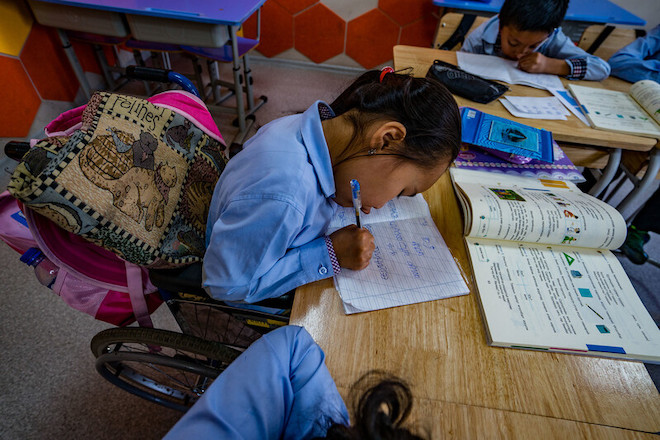
This article is published in collaboration with the Economic Research Institute for ASEAN and East Asia.
Southeast Asia faces a particularly opportune time. The rapid growth of the digital economy continues to offer many opportunities to bridge gaps in education, employment, and well-being across the region. The speed of the growth of the digital economy, however, has not been even across the region. Some people are becoming significantly better off than others. People with disabilities are often overlooked in this transition and may face dire consequences if they are not brought into the fold.
ERIA’s report, Technology and Disability: Trends and Opportunities in the Digital Economy in ASEAN, addresses this concern by highlighting the role digital technology can play in transforming the lives of people with disabilities in the ASEAN region. As authors of the study say, “people with disabilities are an overlooked source of innovative talent.”
Technology can help tap this talent. Technology can provide opportunities for people with disabilities to participate more fully in the workforce, to access education, and to lead more independent lives. This work would help to address the 472 million people with disabilities of working age in the Asia–Pacific region, who are already two to six times less likely to be employed than their peers without a disability.
One way digital technology can promote the inclusion and empowerment of people with disabilities is through tech-enabled working environments. These environments can include the provision of assistive technologies and tools to help level the playing field and provide accommodation needed to allow people with disabilities to do their job. The study shared the work of a social enterprise in Thailand called Steps, which is working with IKEA to create a blueprint for an inclusive office with IKEA products, dispelling the belief that accommodations for people with disabilities are more expensive than for those without disabilities. Technology can also create virtual and flexible working environments that allow people with disabilities to work from home or at other locations that are more accessible to them.
Another area where digital technology can make a real impact is through the creation of digital jobs, including engagement in the hiring phase for these jobs. The study revealed many people with disabilities face significant barriers to employment, but digital jobs can provide new opportunities for people with disabilities to work and contribute to their communities. Artificial intelligence-powered tools can be used in the hiring process to limit biases against people with disabilities. These digital jobs can be performed from anywhere with an internet connection, making them more accessible to people with disabilities and removing many of the physical and social barriers that can prevent people with disabilities from physically participating in the workforce.
Finally, digital technology can play a key role in improving access to education for people with disabilities. With the rise of online and distance learning, people with disabilities are no longer limited to studying in physical classrooms and can access education from anywhere with a reliable internet connection. This can help to break down barriers to education and improve the chances of people with disabilities to achieve their full potential. However, comprehensive, and ongoing teacher training to adopt universal learning design principles such as adapting the curriculum to individual student needs, as well as reliable access to the internet are critical factors that can enable access to online learning for all learners. In terms of access to the internet in the ASEAN region, access to the internet can range from 1.7% in Lao People’s Democratic Republic to 98.4% in Singapore. Governments must support infrastructure to support this kind of learning across the region to ensure all people with disabilities have equitable access to online learning.
To fully realize the opportunities mentioned, multiple stakeholders must take action to ensure that digital technology is accessible, inclusive, and empowering for people with disabilities. After all, all people belong in the workplace and have the right to contribute to society socially, politically, and economically, including people with disabilities. The study offers a compelling framework for action for stakeholders across government, businesses, and civil society, to ensure technology is accessible, inclusive, and empowering for people with disabilities. We must remember, people with disabilities are agents of their own future. Technology can help give them agency and tools to participate fully and thrive in a digital world.
References
- 2020. Employment of Persons with Disabilities in Asia and the Pacific: Trends, Strategies and Policy Recommendations’, Social Development Division Policy Papers, No. 2020/13 (accessed 5 February 2023).
- Statistica, Share of Population with Internet Access at Home in the Asia-Pacific Region in 2020, by Country or Territory (accessed 5 February 2023).
- Ton. 'IKEA Collaborates with STEPS to Set up an 'Inclusive Office' Creating a World That Welcomes All Diversity.' Steps Community (accessed 5 February 2023).
This article was first published by The Voice of Vietnam on 11 March 2023.
 Rubeena Singh
Rubeena Singh
Inclusive Education Consultant, ERIA
Rubeena Singh authored the ERIA report, Inclusive Education in ASEAN: Fostering Belonging for Students with Disabilities, which analyzes the inclusive education landscape in ASEAN amid the pandemic and provides policy recommendations to improve inclusive education systems in the region. She is currently the manager for research and knowledge at research and strategic communications agency Kite Insights.


